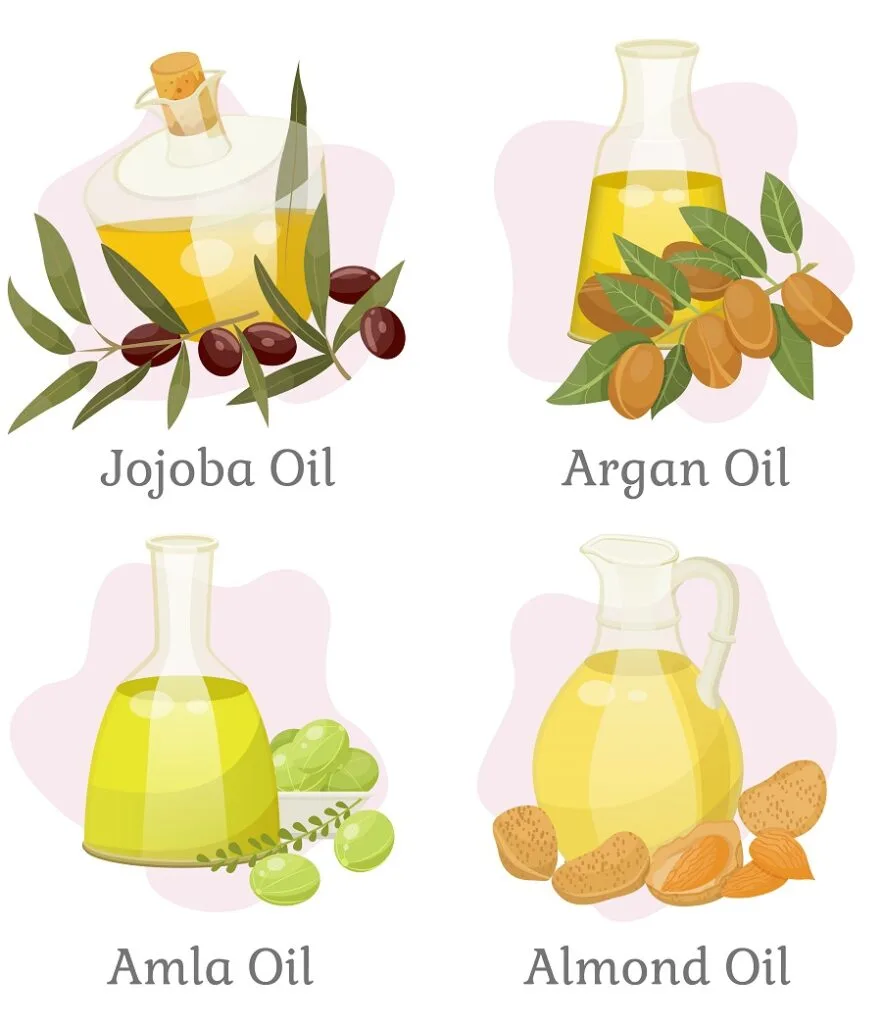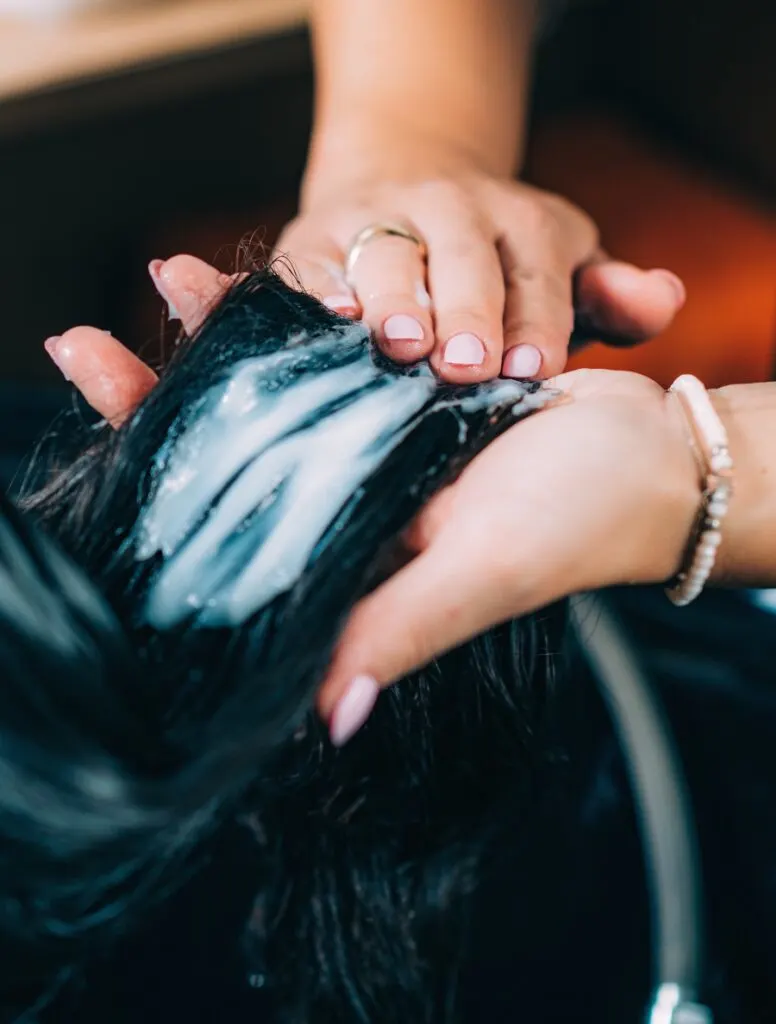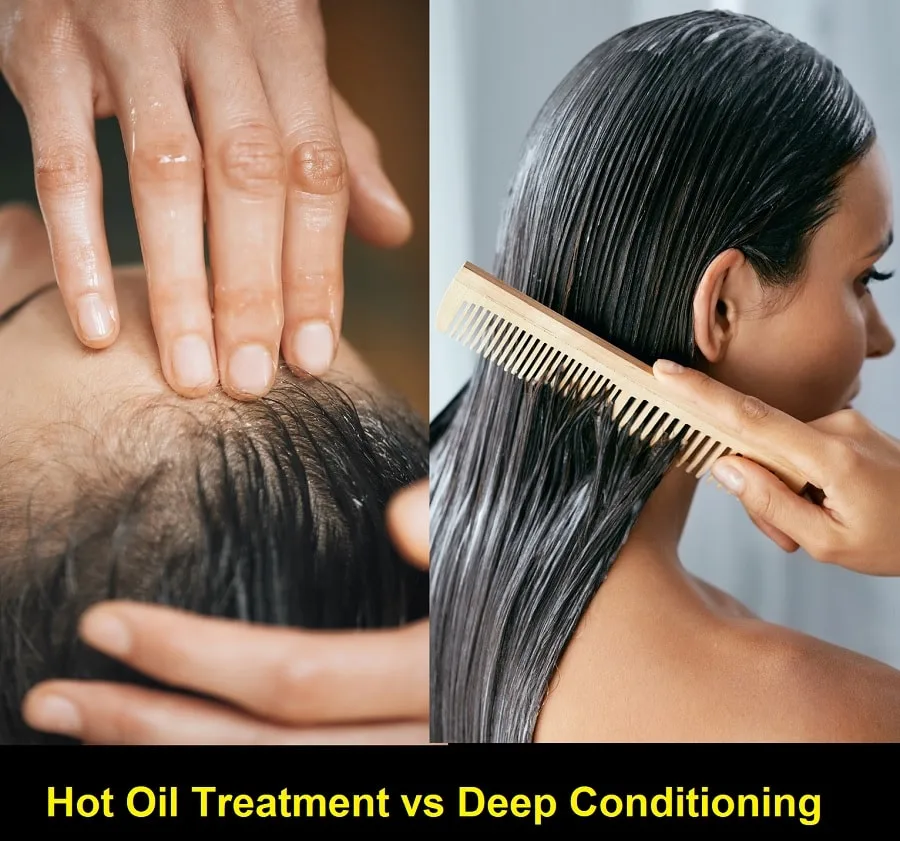Everyone’s talking about natural ways to make hair look healthy in the era of chemical treatments and regular heat styling. And let’s be honest, who doesn’t want that?
Hot oil treatments and deep conditioning are popular because they work wonders without all those harsh chemicals you’ll find in most hair products! These hair treatments are different in their uses, pros, and cons.
If you’re wondering which one is best for you, no worries! In this article, we’ll highlight the key differences between hot oil treatment and deep conditioning.
What Is Hot Oil Treatment?

Hot oil treatment is a hair care process that involves applying warm oil to deeply condition, moisturize, and nourish both the hair and scalp.
The purpose of this process is to nurture hair strands and protect them. This eventually leads to strengthening the hair.
You can use different types of oils like coconut, olive, almond, or argan oil for hot oil treatment, depending on your hair type and individual needs.
Pros
- Restores the lost shine of hair
- Improves blood circulation in the scalp and allows it to breathe
- Helps in reducing dandruff
- Can be effective in reducing hair loss
- Maintains your hair moisture and prevents dryness
Cons
- People with sensitive skin may experience adverse reactions when using it
- Doesn’t suit people with itchy scalp
What Is Deep Conditioning?

As the name suggests, deep conditioning is the intense version of regular hair conditioning. People use this type of treatment when regular conditioners don’t provide the desired results.
Deep conditioning can help restore dry, dull hair and bring it back to life. It comes in the form of a thick hair mask that you need to apply to your hair relatively longer than regular conditioners.
There are multiple types of deep conditioners, each focusing on treating specific hair issues. One may compensate for the lack of protein in the hair, while another might aim to increase the moisture in your hair.
Pros
- Provides hair with a smoother and softer texture
- Helps moisturize hair that is dry due to the frequent use of dye
- Makes tangled hair easier to brush
- Can provide your hair with a pleasant scent that lasts for hours
- Helps in repairing the damaged strands
Cons
- It can make some people’s hair feel greasy
- Not suitable for fine hair
- High-quality deep conditioning can be expensive
- Damages hair color
Difference Between Hot Oil Treatment and Deep Conditioning
Here’s a comparison table that provides an overview of how these treatments differ in benefits, suitability for hair types, duration of effectiveness, ingredients, temperature, and application time.
| Hot Oil Treatment | Deep Conditioning Treatment |
|---|---|
| Primarily used to nourish and protect the scalp, preventing hair damage. | Focused on treating the hair shafts, aiding in moisture retention, detangling, and enhancing shine. |
| Involves warming the oil to activate its ingredients. | Does not require heating; some ingredients may feel uncomfortably cold to some users. |
| Made from natural oils and extracts such as coconut, almond, olive oil, hibiscus, and curry leaves. | May include various ingredients; it’s important to read and follow directions carefully. |
| Typically applied before shampooing the hair. | Applied after shampooing, on clean hair and scalp, free from oil and dirt. |
Now, let’s get into our in-depth comparison to determine which hair treatment is better for your hair type.
1. Core Benefits
Hot oil treatment and deep conditioning each come with distinct benefits.
Hot oil treatment improves the condition of your damaged hair and makes it more elastic. It also prevents hair breakage in the long run.
In addition, here are the other main benefits you’ll get when using this type of treatment:
- Reduces the negative impact of harmful substances in hair care products
- Reduces split ends
- Treats dullness and dryness of the hair by profoundly moisturizing it
Deep conditioning prevents tangles and seals the hair’s moisture. Unlike hot oil treatments, it works mainly on the top layer of the cuticle.
Besides these benefits, it also provides the following advantages:
- It makes hair strands look smoother by enhancing their damaged areas
- Improves the appearance and texture of the hair by neutralizing the negative charge of the hair fibers
- Minimizes hair frizz, making it easier to brush and detangle after wash
- Boosts the effectiveness of hair’s natural oil
The Takeaway
Each one of the two solutions has its benefits. You should use both hot oil and deep conditioning treatment to get the best result.
2. Ideal Hair Type
Each of the compared hair care solutions targets different needs and preferences, as indicated below.
People with dry, frizzy, brittle, or color-treated hair should prioritize using hot oil treatment. Given that, if your scalp is greasy, you need to pick lightweight oils like almond oil and olive oil.
On the other hand, if your hair is extremely dry, it’s better to use thicker oil, such as coconut oil.
Deep conditioning suits most damaged, textured, and even dry hair types. However, it doesn’t suit people with thin, oily hair as it can be heavy on these types of hair.
It is also not recommended to leave your hair in a deep condition after coloring it, as doing so may cause your hair color to fade or become uneven.
The Takeaway
A hot oil treatment improves color-treated, frizzy, and brittle hair. If your hair is textured or damaged, deep conditioning is the way to go. That said, both work perfectly on moisturizing dry hair.
3. Duration of Effectiveness
Hot oil treatment results are long-term. It can increase your hair’s softness, thickness, and overall health over time due to its high nutritional value.
Deep conditioning results are relatively short-run. It helps make your hair softer and smoother temporarily. So, you need to use it continuously to maintain the desired results.
The Takeaway
Deep conditioning provides great short-term results, but hot oil treatment offers long-term effects.
4. Ingredients
Each of the hair care solutions can be made of various valuable ingredients. Let’s take a look at them.
Hot oil treatment is made mainly of one or multiple oils that your hair can absorb perfectly. You can purchase a pre-made product or DIY it. Here are the most common oils used in this treatment:
- Argan oil
- Sweet almond oil
- Sesame oil
- Jojoba oil
- Grapeseed oil
- Extra virgin olive oil
- Amla oil
Deep conditioning masks can include various ingredients that fall into two categories: humectants and emollients.
Some of these ingredients include eggs, apple cider vinegar, lemon juice, banana, henna, olive oil, and mayonnaise, to name a few.
The Takeaway
Hot oil treatment consists mainly of one or more natural oils. On the other hand, deep conditioning products include a wide variety of humectants and emollients. Both can share a few ingredients, like olive oil or coconut oil.
5. Temperature
Hot oil treatment is, of course, hot, while deep conditioning is cool. Still, there’s more to know about the temperatures of both.
It’s essential to warm up oils before using them when applying hot oil treatment. However, you should be careful not to heat these oils to a temperature that can scald you. Excessively high temperatures of oil can deactivate some of the treatment’s active ingredients.
Deep conditioning doesn’t usually require any type of temperature manipulation. Nonetheless, some ingredients in deep conditioners can be a little cold, depending on the product or recipe.
The Takeaway
Deep conditioning can contain cold ingredients. Conversely, as its name shows, hot oil treatment is only used when hot.
6. Application Time and Duration
Following the recommended time and duration for applying each of these solutions is crucial.
You’ll need to apply and leave hot oil treatment on your scalp for around 30 to 45 minutes.
After that, you should wash your hair to remove the excessive oil. For this reason, hair oil treatment should be used before washing the hair.
You should leave deep conditioning on your hair for around 22 to 40 minutes. It also requires your hair to be free of dirt or excessive oil. That way, it is typically used after hair washing.
The Takeaway
You should apply deep conditioning for 20 to 40 minutes. You should use it after hair washing.
On the other hand, you need to use a hot oil treatment for 30 to 45 minutes. It’s recommended to use it before washing your hair.
So, Hot Oil Treatment or Deep Conditioning: Which Is Better?

If you have dry, frizzy, thin, or color-treated hair, hot oil treatment is better for you. For damaged or textured hair, you should choose deep conditioning.
That said, these two hair care solutions aren’t necessarily alternatives; you can also take both treatments if you get the benefits of each.
In any case, remember that it takes time to start noticing results when using hair care solutions. That way, you need to be patient and use the treatment consistently.
Trending Topics:
